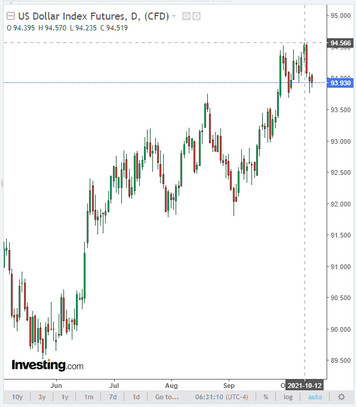Last Wednesday, gold prices rose sharply after the release of fresh data on US inflation, and the dollar fell sharply. The XAU / USD pair reached the important long-term resistance level 1795.00 on Wednesday, and briefly broke it on Thursday, climbing to the psychologically significant level 1800.00 dollars per ounce. Gold is a traditional defensive asset when inflation rises. But it is also extremely sensitive to changes in the monetary policy of the world's largest central banks, primarily the Fed.
A September report from the Bureau of Labor Statistics, released on Wednesday, indicated that consumer inflation remained elevated last month, which in turn was also fueled by a sharp rise in energy prices (electricity prices rose 1.3% in September, for food - by 0.9%, and for gasoline - by 1.2%). The consumer price index (CPI) rose 0.4% compared to August and 5.4% in annual terms. Energy prices continue to rise, and supply problems and critical commodity shortages persist.
According to another report released earlier in October, the PCE (Personal Consumption Expenditure Index) grew 4.3% (year on year), the highest in three decades. The Fed prefers this indicator to measure inflation.
Inflation in the US is forecast to be 4.3% this year by the International Monetary Fund report realised earlier this week, before falling to 3.5% in 2022 and 2.3% in 2023.
At the same time, according to the weekly report released on Thursday by the US Department of Labor, the number of applications for unemployment benefits fell to 293,000 from 329,000 a week earlier. Previous values of this indicator: 364 thousand, 351 thousand, 335 thousand. The number of applications remains at the lowest levels since the beginning of the pandemic. The minimum of 312,000 applications was reached in the week of August 29 - September 4.
The data show a gradual improvement in the US labor market. The Labor Ministry's report published earlier this month indicated that the unemployment rate in the country dropped to 4.8% from 5.2% in August. Employers are holding on to employees in conditions of lack of available resources in the labor market, attracting them with higher salaries, which is also an accelerating factor in inflation.
In December, Fed officials said the bank would buy bonds at the current pace until the economy sees “significant further progress” towards the Fed's targets, when the economy recovers 10 million jobs lost since the start of the pandemic and inflation returns to target level 2% over time.
In August, Fed Chief Powell said most executives believed the inflationary progress needed to curtail asset purchases had been made, and employment remained a major hurdle. The economy created about 4.9 million jobs through September, which helped restore about half of the lost jobs that were in December. As far as the Fed's employment target is concerned, “I think it is almost achieved”, Powell said.
Thus, the latest data should be enough for the Fed to decide that now is the time to cut back on $ 120 billion a month of bond purchases.
At the same time, the reduction in the volume of purchases of bonds does not mean at all that the Fed will soon also start raising the interest rate.
The minutes from the September 21 and 22 Fed meeting released Wednesday showed that half of the 18 executives expect the economy to need interest rate hikes by the end of 2022, and almost all executives anticipate another rate hike in 2023.
Thus, despite the expected reduction in the volume of the stimulus program, the Fed's monetary policy remains soft, which is a positive moment for gold. At the time of publication of this article, the XAU / USD pair is traded near the 1783.00 mark.
And if inflation continues to grow, then one should expect an increase in quotations of this precious metal, provided that the Fed does not start raising the interest rate earlier than planned, i.e. by the end of 2022.
Today investors will pay attention to the publication at 12:30 and 14:00 (GMT) of the latest data on retail sales in the United States (expected to decline slightly by -0.2% in September) and the preliminary consumer confidence index of the University of Michigan, which reflects the confidence of American consumers in the economic development of the country.
This indicator is expected to be released in October with a value of 73.1. The data indicate that the recovery of this indicator is uneven, which is negative for the USD.
As of this writing, DXY futures are traded near 93.93, 64 points below the local multi-month high reached earlier this week.

Worse-forecast data on retail sales and consumer confidence may negatively affect the dollar in the short term.





